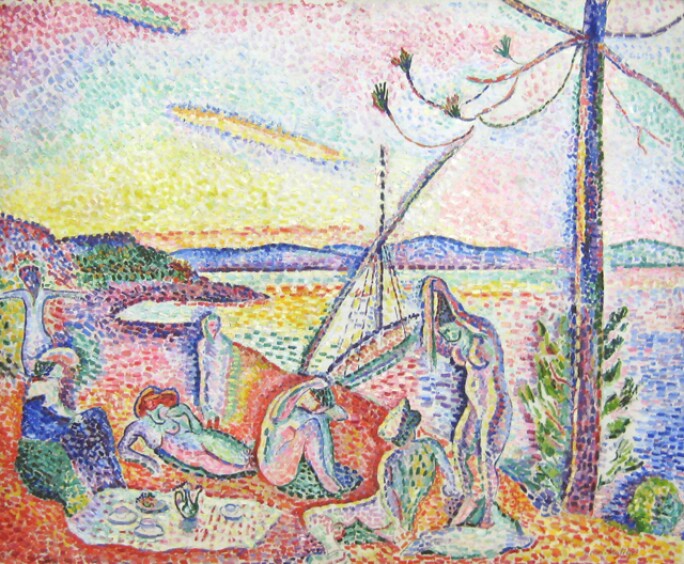Pointillism was a revolutionary painting technique pioneered by Georges Seurat and Paul Signac in Paris in the mid-1880s. It was a reaction against the prevailing movement of Impressionism, which was based on the subjective responses of individual artists. Pointillism, by contrast, demanded a much more scientific approach – as we’ll see below.
Along with Seurat and Signac, leading members of the group included their fellow Frenchmen, Henri-Edmond Cross and Maximilien Luce. Other well-known artists who briefly made works in Pointillist style were van Gogh and, early in their careers, Picasso, Mondrian and Kandinsky.

1. Points of pure colour: Pointillism involved the application of paint in carefully placed dots of pure, unmixed colour. According to Seurat and Signac, these would be blended by the viewer’s eye to create a more striking image than any made after mixing colours conventionally on a palette.
Seurat – whose life was cut short by diphtheria, aged 31 – created two of the undoubted masterpieces of the movement: Un Dimanche Après-Midi À L'île De La Grande Jatte (1884-86, now in the Art Institute of Chicago) and Une Baignade, Asnières (1884, in the National Gallery in London).
2: Science of the eye: As important to Pointillism as any artist was the French chemist, Michel Eugène Chevreul – and his book, Principles of Harmony and Contrast of Colours. Employed by a Parisian tapestry works that wished to improve the strength of its colours, he discovered that the issue wasn't the dyes being used but the way different hues were being combined.
In short, the visual impact of a tapestry was actually a matter of optics, not chemistry. It depended on the juxtaposition of complementary colours (which enhanced each other's intensity) – blue and orange, for example. Seurat and the Pointillists drew heavily on Chevreul’s discoveries, applying to paints what the chemist had found in threads.

3. 'Painting by dots': The movement's name derives from a review of Seurat's work by the French art critic, Félix Fénéon, who used the expression peinture au point (“painting by dots”). Seurat actually preferred the label "Divisionism" – or, for that matter, Chromoluminarism – but it was Pointillism that stuck. As for Fénéon, one of the movement’s great champions, he'd go on to be immortalised in a celebrated canvas, Signac's Portrait of Félix Fénéon, from 1890, now part of the Museum of Modern Art (MoMA) collection in New York.
4. Meticulous technique: Pointillism is regarded as a Neo-Impressionist movement. Which is to say, it grew out of – and beyond – Impressionism. Works such as Un Dimanche Après-Midi À L'île De La Grande Jatte were even exhibited as part of the eighth (and final) Impressionist exhibition, in Paris in May 1886. Like members of that earlier movement, Pointillists wished to render optical phenomena. However, they renounced fluid, spontaneous strokes in favour of a measured, meticulous technique.

5. Van Gogh and Pointillism: Vincent van Gogh, who knew Seurat and Signac from his time living in Paris from 1886 to 1888, had a brief association with Pointillism. Certainly some of his paintings from that Parisian period – such as 1887's Self-Portrait – show hints of its influence. (After a visit to Seurat’s studio one day, he claimed to have experienced a “revelation of colour”.) It's generally agreed, however, that van Gogh was too restless a spirit for a style as technical as Pointillism.
Another famous artist who briefly embraced Pointillism around this time was Camille Pissarro. Turning his back on the Impressionist style with which he'd made his name, he was hailed by one Parisian critic as "a master who continually and courageously adapts to new theories".
6. Music of the dots: Musical metaphors were occasionally used to help describe Pointillism, most straightforwardly that of the coloured dots being in a kind of harmony. Signac – who took over as the movement’s de facto leader after Seurat’s death in 1891 – likened the process of choosing his colours to that of a composer considering each instrument while creating a symphony.

7. From Pointillism to Fauvism: With its strident colour combinations, Pointillism was a clear influence on Fauvism, among other movements: Henri Matisse's Luxe, Calme et Volupté (1904, now in the Musée d'Orsay) is often cited as an important work of transition between the two.
Beyond the art world, Un Dimanche Après-Midi À L'île De La Grande Jatte would inspire the hit Stephen Sondheim stage musical, from 1984, Sunday in the Park with George.
Explore more from The Art of the Season

